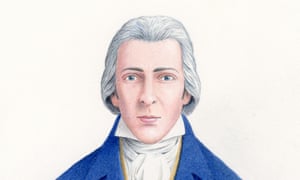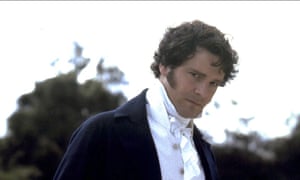Experts believe Jane Austen’s ideal Darcy would bear little comparison to the one played by Colin Firth in BBC’s 1995 series

Academics have suggested the literary heartthrob had powdered white hair, slender shoulders, a long nose and a pointy chin. Photograph: UKTV/Nick Hardcastle/PA
A dispiriting portrait of the “real” Mr Darcy, showing Jane Austen’s Pride and Prejudice hero as a pale, slope-shouldered, weedy character, thin of mouth and chin with his hair powdered white, has been created by a panel of experts through studying contemporary fashions and social history.
Their conclusions have been embodied in a portrait by the illustrator Nick Hardcastle, unlikely to set many 21st century hearts aflutter.
When Mr Fitzwilliam Darcy first walks into literature, at an assembly rooms dance in Meryton, Jane Austen provides remarkably few clues about his appearance. He attracts more admiring glances than his friend Mr Bingley, who is described as “good looking and gentlemanlike”. However, with a typically sardonic flourish, Austen writes: “Mr Darcy soon drew the attention of the room by his fine, tall person, handsome features, noble mien, and the report which was in general circulation within five minutes after his entrance, of his having ten thousand a year.”
Casting directors have generally interpreted this as tall, dark and ruggedly handsome, personified by Colin Firth in the famous wet shirt 1995 television version. Indeed the screenwriter Andrew Davies recently revealed that Firth was forced to dye his naturally reddish brown hair a darker shade for the role.

FacebookTwitterPinterest Firth was forced to dye his naturally reddish brown hair a darker shade for the role in the 1995 drama. Photograph: Allstar/BBC/Sportsphoto Ltd
The experts, including the academic John Sutherland and the historian and author Amanda Vickery, commissioned by the Drama Channel to come up with the Darcy Austen might have envisaged, conclude that a tanned complexion, broad shoulders and muscular chest would not have been seen as attractive by Austen’s Georgians, signifying a hardworking outdoor labourer, not a gentleman of leisure. They do permit him strong muscular legs, toned by horse riding and fencing, as a desirable attribute.
The ideal for gentlemanly good looks in Austen’s day, they believe, was a smooth youthful complexion, with a small pointy chin and small mouth, under hair worn long but tied back and powdered white, as seen in many aristocratic portraits.
Vickery says of their version of the character: “As Austen wrote Pride and Prejudice in the 1790s, our Mr Darcy portrayal reflects the male physique and common features at the time. Men sported powdered hair, had narrow jaws and muscular, defined legs were considered very attractive. A stark contrast to the chiselled, dark, brooding Colin Firth portrayal we associate the character with today.”
Sutherland believes the enigma is part of Darcy’s charm: “There are only scraps of physical description of Fitzwilliam Darcy to be found in Pride and Prejudice; he is our most mysterious and desirable leading man of all time. What’s fantastic about Jane Austen’s writing is that Mr Darcy is both of the era and timeless.”
Various historical figures have been suggested as Austen’s model for Darcy, including an Irish law student Tom Lefroy – later a judge and MP – with whom she is said to have had a brief youthful romantic attachment. Others believe he was based on the first Earl of Morley, John Parker, married to a friend of the author’s. The truth may have been lost in the many letters her sister, Cassandra, burned after her death.
The research on the real Mr Darcy was commissioned by the Drama Channel to launch its Jane Austen season, which starts on Valentine’s Day.
Since you’re here …
… we have a small favour to ask. More people are reading the Guardian than ever but far fewer are paying for it. And advertising revenues across the media are falling fast. So you can see why we need to ask for your help. The Guardian’s independent, investigative journalism takes a lot of time, money and hard work to produce. But we do it because we believe our perspective matters – because it might well be your perspective, too.
If everyone who reads our reporting, who likes it, helps to pay for it, our future would be much more secure.
No comments:
Post a Comment